calsfoundation@cals.org
Devil's Den State Park
| Location: | Washington County |
| Area: | 2,200 acres |
Devil’s Den State Park in the Boston Mountains of northwest Arkansas is one of the best-preserved Civilian Conservation Corps (CCC) park developments in the United States and contains the largest sandstone crevice cave area in the country. The park is popular for a variety of recreational opportunities and was designated a Natural Area by the Arkansas Natural Heritage Commission.
The Arkansas Archeological Survey in 1979 recorded eleven archaeological sites at the park. Six sites are prehistoric and indicate the presence of Native Americans as far back as 8,000 years. Archaeological evidence of European-American settlement indicates that whites probably settled in the area before 1836, the year Arkansas became the twenty-fifth state. Settlement of upper Lee Creek Valley steadily increased during the 1840s and 1850s, with settlement of the area reaching its height from 1880 to 1920.
As with other early state parks in Arkansas, the land for Devil’s Den State Park was acquired by the federal government after it was forfeited by families who could no longer keep up with taxes on their property during the Great Depression.
Devil’s Den State Park was created on October 13, 1933, which coincided with the creation of the CCC by President Franklin D. Roosevelt. The first CCC company occupied Devil’s Den State Park on October 20, 1933. The main goal of this unit, made up of men from North Dakota, was to construct a good gravel road from West Fork (Washington County) to Devil’s Den. The road later became Arkansas 170. The CCC also built the first hiking trails in the park, as well as a stone dam on Lee Creek, cabins made of native stone and logs, campgrounds, offices, and a restaurant. Construction of trails, roads, and other minor buildings continued until the CCC disbanded in 1942.
Cabins began to deteriorate in the 1950s, and the state had little funding available for maintenance and facility development. During this time, one cabin burned, and other buildings were removed or lost. Much-needed renovation of CCC cabins and other facilities—campgrounds, swimming pool, maintenance compound, an employee residence, and water/wastewater treatment systems—occurred in the 1960s and 1970s. Nevertheless, several CCC-era structures were lost. The rustic log-and-stone bridge that crossed Lee Creek washed away in a flood and was replaced by a modern highway bridge still in use today. Another cabin was destroyed by fire around 1967, and the logs of the rustic overlook shelter rotted and were replaced with new lumber.
Lee Creek dam, completed on April 1, 1937, was damaged by floodwaters on April 24, 2004, due to heavy rain in Lee Creek valley which raised Lee Creek to a record level.
While some CCC-era structures have been lost, the park is one of the most complete and best-preserved CCC-era parks in the country. In 1994, the entire park was designated a National Historic District and placed on the National Register of Historic Places. In 1999, the significance of the CCC-era landscape design at the park was recognized by the American Society of Landscape Architects when it presented the park a Centennial Medallion Award.
The parkland is in the Boston Mountain subdivision, the southernmost, highest, and most severely eroded of the three plateaus that form the Ozark Mountains. Lee Creek, which runs through the park, has cut through layers of sandstone, shale, and limestone to expose them to view.
The most unique portion of the park is the sandstone crevice area, which contains approximately sixty crevice caves. The longest is Devil’s Den Cave, extending 550 feet into the hillside.
Geologists believe that, between 10,000 and 70,000 years ago, about thirty acres of hillside collapsed and slid into the valley, causing massive blocks of sandstone to fracture and form numerous crevices and caves. In 1982, the Devil’s Den Crevice Cave Area was placed on the Arkansas Natural Heritage Commission’s Registry of Natural Areas. The crevice caves provide a habitat for numerous bat species, including the Ozark big-eared bat, an endangered species. The bats hibernate in Big Ear Cave, one of only four known caves in Arkansas considered essential to the survival of the species. While park-goers can explore caves and crevices throughout the park, Big Ear Cave is off-limits and protected by a special alarm system. One of the most popular annual events at the park is Bat-O-Rama, which addresses the park’s expanding colony of big brown bats.
The park contains a Civilian Conservation Corps Memorial Statue, dedicated near the dam site on June 30, 2002. The memorial statue is a six-foot bronze of a CCC worker set on a four-foot pedestal with a commemorative plaque attached.
Devil’s Den has hiking, mountain biking, and backpacking trails that lead to caves, crevices, and bluff overlooks. There are cabins, campgrounds, a cafe, and a swimming pool. A store provides groceries and gifts. The horse camp area includes riding trails and a bathhouse. Interpreters guide visitors on hikes along several trails, including the fifteen-mile Butterfield Hiking Trail, and provide games and programs daily during the summer.
For additional information:
Burggraf, Frank. “The Development of Devil’s Den State Park.” Flashback 63 (Spring 2013): 3–41.
Devil’s Den State Park. Arkansas State Parks. http://www.arkansasstateparks.com/devilsden/ (accessed June 4, 2014).
Yount, Sheila. “Vernal, Not Infernal.” Arkansas Democrat-Gazette, October 21, 2024, pp. 1D, 6D. Online at https://www.arkansasonline.com/news/2024/oct/20/state-parks-spotlight-incongruently-named-devils/ (accessed October 23, 2024).
Staff of the Arkansas Department of Parks and Tourism
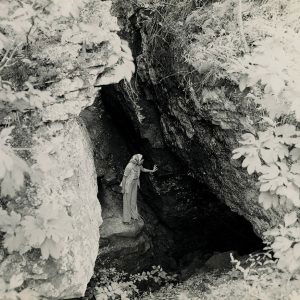
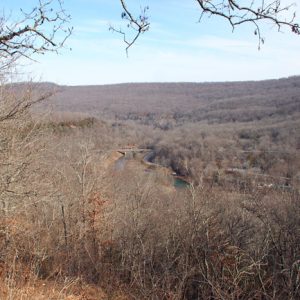
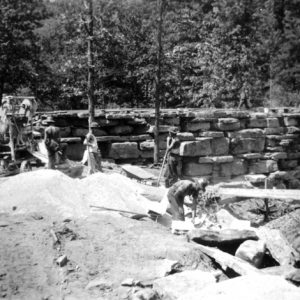
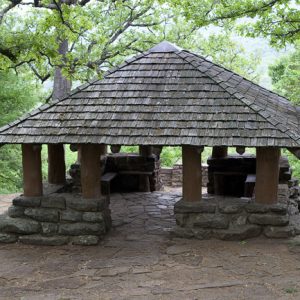
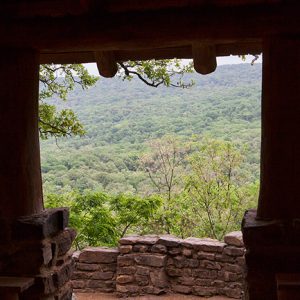
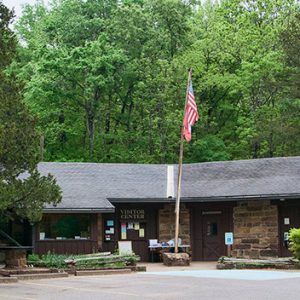
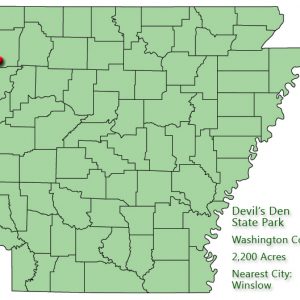
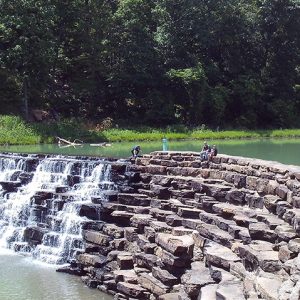
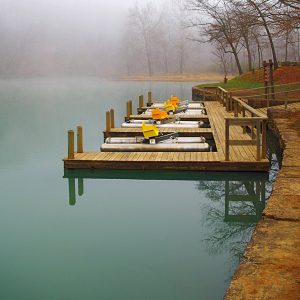
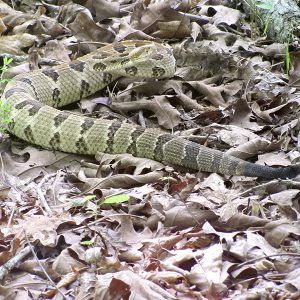
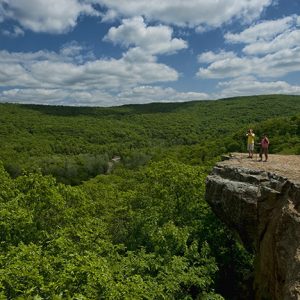




Comments
No comments on this entry yet.